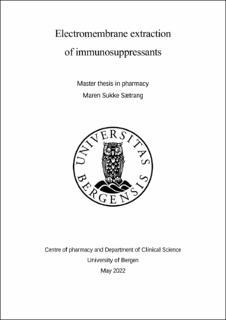Electromembrane extraction of immunosuppressants
Master thesis

View/
Date
2022-05-20Metadata
Show full item recordCollections
- Master theses [30]
Abstract
Tofacitinib (TFB) and cyclosporine A (CsA) are two immunosuppressants that can cause toxic adverse effects or treatment failure if not dosed properly. Both these drugs have the potential to be affected by individual variability in pharmacokinetics, and interactions with other drugs and nutrients. Therapeutic drug monitoring (TDM), based on serum concentration measurements, could benefit patients in need of these drugs, to ensure safe treatment. Effective sample preparation techniques are essential to precisely determine the concentration of a drug within pharmaceutical bioanalysis. This is to avoid interference from matrix components and prevent contamination or damage of the analytical instrument. Electromembrane extraction (EME) is a sample preparation technique that was developed in 2006. Over the years, this technique has proven to be efficient for both acidic, basic, polar and non-polar analytes. The concept of the extraction is electrokinetic migration of the analyte by an external power supply over a three-phase system consisting of two aqueous solutions (donor and acceptor), separated by a supported liquid membrane (SLM) comprised of an organic solvent. EME has several advantages, including high sample clean-up and selectivity, enrichment with the possibility of pre-concentration, and low consumption of organic solvents. In this study, EME was for the first time investigated as a sample preparation technique for the immunosuppressants CsA and TFB. The EME method development for CsA was obstructed by the lower limit of detection with HPLC-UV, at 2 µg/mL, and the solubility of the analyte. CsA was attempted to be extracted as an anion with highly alkaline conditions using a 10 mM NaOH solution with pH 10 in both donor and acceptor, and 1-octanol as SLM. CsA was not detected in the acceptor solution, and the highest mean recovery of analyte from the donor solution and SLM was 24% at 20 V. For the method development of TFB, a range of different conditions, i.e. pH, SLMs, voltage and extraction time, were tested and optimized in order to yield high recoveries of the analyte. The aqueous samples without plasma were analyzed by HPLC-UV at 40˚C with an isocratic mobile phase of 10 mM ammonium acetate pH 5 and acetonitrile (60:40). An absolute recovery (100%) of TFB was obtained after 45 minutes of extraction as a cation from diluted plasma with pH 2.1 at 30 V, using an acceptor solution of 100 mM formic acid with pH 2.4 and a SLM comprised of 6-methylcoumarin and thymol mixed in a weight to weight ratio (1:2). A similar method yielded 79% recovery after 15 minutes extraction from a donor solution of 100 mM formic acid with pH 2.4. In conclusion, EME extraction appears as a promising sample preparation technique for TFB, but further optimization is needed to conclude if it is viable also for CsA.